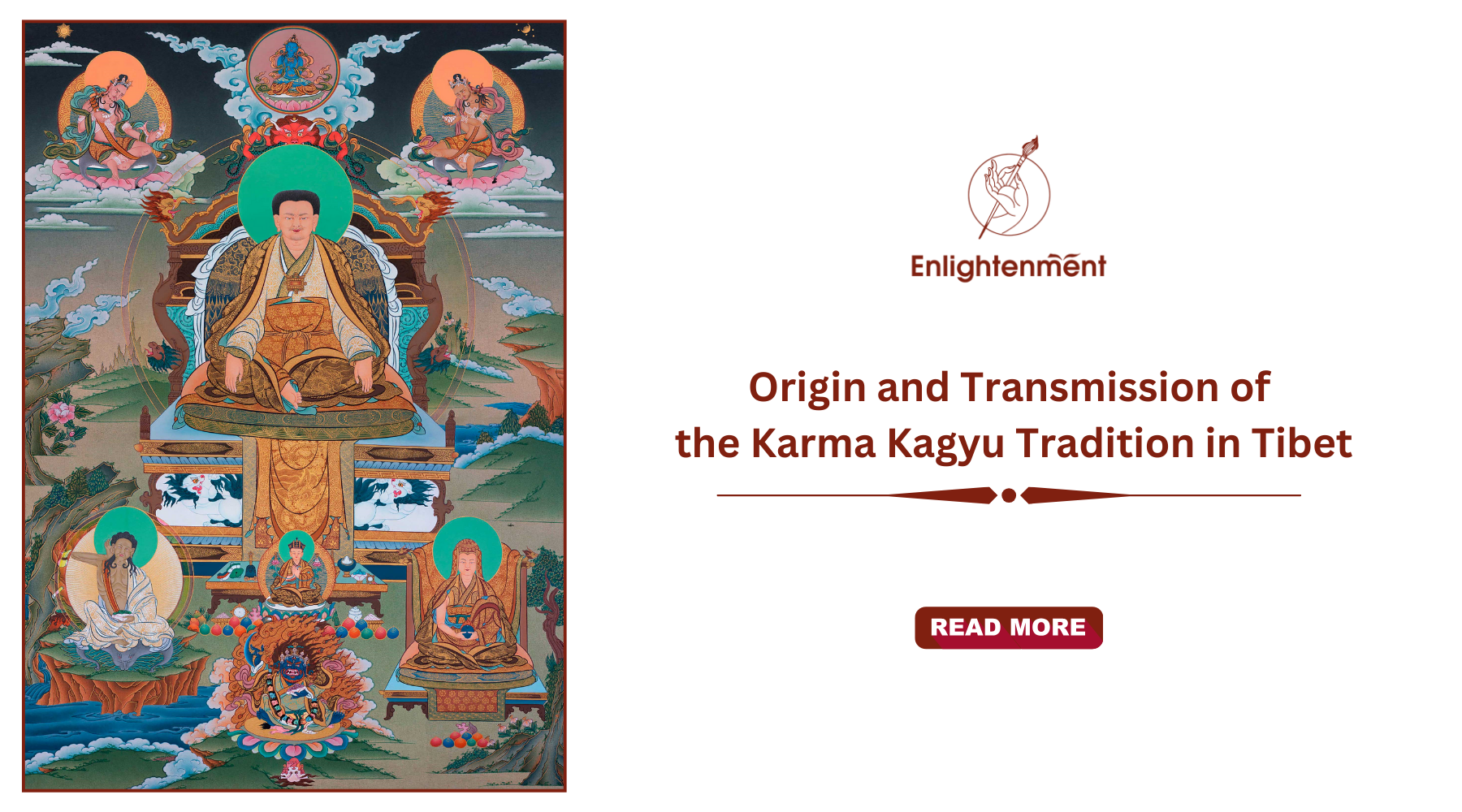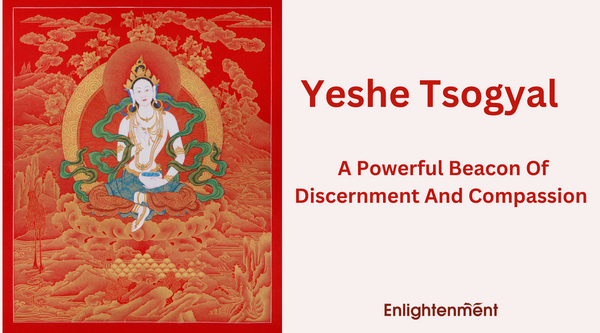Karma Kagyu Is the Most Prominent Lineage In Kagyu school
The Karma Kagyu tradition is an eminent sect of the Kagyu school of Tibetan Buddhism. The Kagyu school is one of the four leading schools of Tibetan Buddhism. Founded by Dusum Khyenpa, the first Karmapa, in the 12th century, the Karma Kagyu tradition emphasizes the importance of direct experience and meditative practice, particularly the practice of Mahamudra (the great seal), which aims to recognize the nature of the mind.
Therefore, the Karmapa tradition is deeply revered for its lineage, teachings, and transformative spiritual practices. Its roots trace back to ancient India, where a profound legacy was laid by Mahasiddhas Tilopa and Naropa, and later carried into Tibet by towering figures like Marpa, Milarepa, and Gampopa.
In this read, delve into the genesis, evolution, and transmission of the Karma Kagyu tradition, highlighting the unbroken chain of wisdom that continues to inspire seekers worldwide.
The Foundations of the Karma Kagyu Tradition
Long before the Karma Kagyu tradition flourished in Tibet, its foundation was laid in the spiritual soil of India by two prodigious figures - Tilopa and Naropa.
Tilopa was a wandering mystic from Bengal who walked the untrodden paths of spirituality, seeking wisdom beyond intellectual understanding. He was widely known for his unconventional methods, and his life was a tapestry of paradoxes. It is said that he used to crush sesame seeds for oil by day and meditate in solitude by night, embodying the unity of worldly and spiritual pursuits.

His epiphanies arose from direct experiences rather than theoretical study passed on by Vajradhara, the primordial dharmakaya Buddha and source of realization. One could connect to him as he came out as a torchbearer in the wilderness, illuminating previously unseen paths. His pivotal teaching, "The Six Words of Advice," briefly encapsulates the path to liberation:
- Don’t recall (letting go of the past).
- Don’t imagine (letting go of the future).
- Don’t think (releasing the present moment's mental chatter).
- Don’t examine (abandoning analytical tendencies).
- Don’t control (releasing the urge to manipulate reality).
- Rest (relax and rest in the present).
The instructions are a method to let go of the past and future and live fully in the present now. It is about letting go of the desire to analyze, comment on, or project manage the present moment. It's also about letting go of the effort to control your experience or make it conform to some ideal.

Naropa, his disciple, was a distinguished scholar at Nalanda University, where he became deeply immersed in Buddhism. However, despite his extensive knowledge, he sought deeper truths that traditional academic pursuits could not provide. He chose to leave his esteemed position to follow Tilopa, facing numerous trials that tested both his commitment and strength. These challenges were not just obstacles; they were transformative experiences meant to dissolve ego and attachment. Their connection illustrated the profound Guru-Disciple relationship, a fundamental aspect of the Karma Kagyu tradition, where the teacher's insights are shared directly with the student, heart to heart.
Under Tilopa’s guidance, Naropa underwent 12 major trials and 12 minor hardships, symbolizing the stripping away of ego and attachment. Each trial revealed another layer of wisdom, emphasizing the necessity of personal transformation over intellectual accumulation. Naropa eventually became a realized master, codifying the teachings of Mahamudra and the Six Yogas, which later became cornerstones of the Karma Kagyu tradition.
Tilopa also passed on the teachings of Mahamudra, known as the "Great Seal." This deep meditation reveals the essence of the mind that is central to Karma Kagyu practices. It is believed that through Mahamudra, one can experience the vastness of enlightenment even while navigating the limits of ordinary perception.
From India to Tibet: Marpa the Translator’s Odyssey

Bringing the wisdom of Tilopa and Naropa to Tibet required a person of remarkable determination and skill. That person was Marpa Lotsawa, often referred to as Marpa the Translator.
Marpa was born in 1012 into a farming family in Lhodrak, Tibet , and showed an unquenchable thirst for spiritual knowledge from an early age. Unlike his peers, who often concentrated solely on monastic practices, he was captivated by the esoteric teachings of India. His journey was not just a geographical adventure but a spiritual quest filled with challenges, dangers, and victories.
Marpa made several trips to India, navigating perilous landscapes, facing robbers, and overcoming exhaustion. He studied under Naropa and other masters, gathering teachings like a bee collecting nectar. He translated these teachings into Tibetan, ensuring they were preserved and accessible. Marpa's efforts were akin to constructing a bridge between two worlds, linking the rich spiritual traditions of India with the developing Buddhist culture of Tibet.

His life illustrates the complex blend of discipline and compassion that characterizes the Karma Kagyu tradition. Although known for his fiery temperament, he was profoundly compassionate, enduring great hardships to bring teachings back to his homeland. His story reminds us that achieving spiritual growth often demands perseverance in the face of challenges.
As the bridge between two languages and cultures, Marpa's efforts extended beyond translation. He established a tradition of direct transmission, ensuring that teachings were passed from teacher to student with integrity and precision. This approach emphasized personal experience and the transformative power of the guru-disciple relationship.
Milarepa: A Poet-Saint and a Paragon of Transformation
Milarepa shines as a symbol of hope among Marpa’s students. His life illustrates the incredible potential of spiritual practice to bring about change. His early life was filled with pain and a desire for revenge. He was born into a wealthy family, but his life took a turn when relatives seized his inheritance, leaving him in poverty. Fueled by anger, Milarepa resorted to black magic, resulting in the deaths of many. However, the guilt he felt drove him to seek redemption.

With Marpa’s mentorship, Jetsun Milarepa faced intense challenges, constructing towers stone by stone only to tear them down again. These tasks were not random; they were intentional ways to cleanse his karma. Through relentless perseverance, Milarepa attained enlightenment, becoming a respected yogi and poet. His songs were filled with metaphors and simplicity that conveyed deep truths in a way that everyone could understand. He likened the mind to a wild horse that needs to be tamed and compared spiritual growth to climbing a steep mountain. His life serves as a reminder that regardless of how grave our errors may be, redemption is achievable through genuine effort and guidance.
Gampopa: The Architect of the Karma Kagyu School

The Karma Kagyu tradition as we know it today owes much to Gampopa, Milarepa’s chief disciple. A physician turned monk, he brought a unique blend of monastic discipline and yogic practices to the tradition. He was born in 1079, and his early life was rooted in medicine and healing. However, he abandoned those skills after encountering Milarepa’s teachings. He synthesized the Kadampa school’s structured approach with the experiential practices of Mahamudra, creating a comprehensive path accessible to both laypeople and monks.
Through Gampopa’s efforts, the teachings of Tilopa, Naropa, Marpa, and Milarepa were codified and institutionalized. His writings, such as The Jewel Ornament of Liberation, serve as roadmaps for spiritual seekers. His teachings emphasize integrating wisdom and compassion, like the two wings of a bird required for flight.
The Emergence of the Karmapa Lineage

The Karma Kagyu tradition is notable for its lineage of Karmapas, starting with Dusum Khyenpa. As the first Karmapa, Dusum Khyenpa exemplified compassion and insight, laying the foundation for a lineage celebrated for its focus on meditation and devotion. His legacy is kept alive, with the lineage being headed by the 17th Karmapa.
The Karmapas are commonly known as the “Black Hat Lamas,” a title derived from the ceremonial black crown that represents their spiritual authority. Each reincarnation carries on the mission of disseminating the Karma Kagyu teachings, adapting them to contemporary needs while maintaining their core essence.
Key Teachings and Practices of the Karma Kagyu Tradition
At the heart of the Karma Kagyu tradition are essential teachings such as Mahamudra, Lojong (mind training), and the Six Yogas of Naropa. These practices create a holistic approach to achieving enlightenment, engaging the body, mind, and spirit.

Mahamudra is often likened to looking into a clear mirror, allowing practitioners to recognize their true nature. The Six Yogas, a technique that offer a path to transcend ignorance and understand the interconnectedness of all things.
The Six Yogas include:
- Dream Yoga: This practice focuses on exploring dreams to gain a deeper understanding of consciousness and reality.
- Clear Light Yoga: In this practice, one aims to reach a profound state of meditation and awareness, allowing for the experience of the mind's true nature.
- Inner Heat Yoga: This involves generating internal heat to cleanse both the mind and body.
- Tummo Yoga: This technique is about fostering inner heat to facilitate spiritual transformation.
- Symbol Yoga: This practice uses symbolic visualizations to uncover insights about the nature of reality.
- Illusion Yoga: This involves recognizing the illusory aspects of the world and seeking liberation from its constraints.
The Six Yogas are regarded as a rigorous and demanding set of practices, yet they are also thought to be very effective in the pursuit of spiritual enlightenment.
The Legacy of the Karma Kagyu Tradition

The Karma Kagyu tradition draws from that wellspring with its unbroken lineage and profound teachings. Its masters, from Tilopa down to the present Karmapa, have given expression to these principles of devotion, compassion, and wisdom. Let their stories remind us that spiritual growth is a journey with its terrors-demanding courage, humility, and unyielding effort.
In a world divided by material pursuits, the Karma Kagyu tradition reminds us of the bottomless potential that lies within every one of us. It encourages us to travel inside, to find within our hearts that wide open sky of enlightenment guided by Bernagchen, the spiritual protector worshipped within the Karmapa lineage.
Like any great river whose tributary flow brings in water from different lands, the Karma Kagyu lineage thrives from the wisdom of different remarkable individuals and the resounding relevance of their messages. In tracing its travels from India into Tibet, we recall universal truths it upheld, which cross borders and transcend time, culture, and place.


